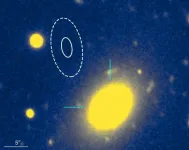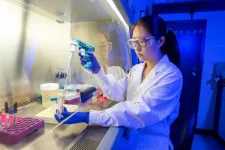(Press-News.org) West Greenland is home to tens of thousands of blue lakes that provide residents drinking water and sequester carbon from the atmosphere. Yet after two months of record heat and precipitation in fall 2022, an estimated 7,500 lakes turned brown, began emitting carbon and decreased in water quality, according to a new study.
Led by Fulbright Distinguished Arctic Scholar and University of Maine Climate Change Institute Associate Director Jasmine Saros, a team of researchers found that the combination of extreme climate events in fall 2022 caused ecological change that “pushed Arctic lakes across a tipping point,” they wrote in a paper published in the the Proceedings of the National Academy of Sciences (PNAS). By July 2023, less than one year later, the physical, chemical and biological properties of these lakes were altered, a widespread transformation that typically occurs over hundreds of years, Saros said. Their results were shared with nearby communities.
Greenland normally experiences snow in the fall, but the spike in temperatures caused the precipitation to fall as rain instead, according to the study. The heat also caused permafrost — frozen soil that stores a significant amount of organic carbon — to thaw, releasing an abundance of carbon, iron, magnesium and other elements. As rain fell in record amounts, it washed these newly exposed metals and carbon from soil into lakes across Greenland’s western region, turning them brown.
Saros, also a professor of paleolimnology and lake ecology with UMaine’s School of Biology and Ecology, said the rapid alteration in West Greenland’s lakes contrasts with the slow, multi-decade-long browning experienced in lakes across the Northern Hemisphere, including those in Maine.
“The magnitude of this and the rate of change were unprecedented,” Saros said.
The influx of dissolved organic carbon and nutrients from the permafrost can promote bacteria growth and produce an undesirable taste and odor in the water, in addition to altering color, Saros said. Increased exposure to metals released from permafrost can also cause health problems. By identifying the type and quantity of organic and inorganic materials entering the lakes following the climate extreme events, residents in the surrounding area can better evaluate how to treat their water.
“The increased dissolved organic material can interact with drinking water treatment processes to produce chlorination byproducts called trihalomethanes, which may be carcinogenic,” Saros said.
With altered physical and chemical properties, the lakes became more opaque and less light was able to penetrate their surface. The reduction in light decreased the biodiversity of plankton, which had significant ramifications for the region’s carbon cycle. Researchers found a decrease in phytoplankton that absorb carbon dioxide from the atmosphere through photosynthesis, and an increase in plankton that break down and release carbon. Instead of sequestering carbon dioxide in the summer, the lakes have become a source of it, with a 350% increase in the flux of this greenhouse gas from them.
“The likely explanation is that so much organic carbon mobilized from the landscape into the surface water, and the organic carbon was available for aquatic organisms to use,” Saros said. “Because the lakes turned so brown, it reduced the light coming into the system, which tends to favor organisms that use organic carbon pathways instead of photosynthesis.”
Researchers concluded that the rise in heat and precipitation was caused by several atmospheric rivers. According to the National Oceanic and Atmospheric Administration (NOAA), an atmospheric river is a long, narrow column of water vapor that produces intense rain or snow when it makes landfall. They affect much of the world, and existing climate models predict that by the end of the century, they will become 50-290% more frequent in Greenland, western North America, east Asia, western Europe and Antarctica.
Saros said additional research and monitoring could help determine how these lakes may recover, providing greater insight into lake dynamics in the region. Further studies can also help scientists examine browning lakes across the Northern Hemisphere, how they may recover and potential treatment and intervention.
“It was such an overwhelming climate force that drove all the lakes to respond in the same way,” Saros said. “When it comes to recovery, will it be the same across lakes or different?”
The study was made possible through extensive data collection obtained through annual water sampling and remote sensors in the lakes that operate year-round.
“Our study demonstrates the power of long-term observation. I’ve been working in this area since 2013, and have worked on many projects here. But in the background, my colleagues and I have been trying to maintain a consistent data set of observations,” Saros said. “That’s how we were able to capture and quantify the effects of this extreme climate event.”
In addition to Saros, UMaine Ph.D. students Václava “Vendy” Hazuková, Grayson Huston, Avery Lamb and Guillaume Bourdin co-authored the study.
Other co-authors include Sean Birkel, Maine state climate scientist and assistant professor with the Climate Change Institute and University of Maine Cooperative Extension; Robert Northington from Elizabethtown College in Pennsylvania; Ryan Pereira from Heriot-Watt University in Edinburgh, Binbin Jiang from Zhejiang University of Science and Technology in China; and Suzanne McGowan from the Netherlands Institute of Ecology. Saros said Binbin and Northington were former postdoctoral associates at UMaine.
“Many Ph.D. students were involved in this work, and were totally instrumental in this work,” she said.
END
Extreme climate pushed thousands of lakes in West Greenland ‘across a tipping point,’ study finds
2025-01-21
ELSE PRESS RELEASES FROM THIS DATE:
Illuminating an asymmetric gap in a topological antiferromagnet
2025-01-21
Topological insulators (TIs) are among the hottest topics in condensed matter physics today. They’re a bit strange: their surfaces conduct electricity, yet their interiors do not, instead acting as insulators. Physicists consider TIs the materials of the future because they host fascinating new quantum phases of matter and have promising technological applications in electronics and quantum computing. Scientists are just now beginning to uncover connections between TIs and magnetism that could unlock new uses for these exotic materials.
A ...
Global public health collaboration benefits Americans, SHEA urges continued support of the World Health Organization
2025-01-21
The Society for Healthcare Epidemiology of America (SHEA) wants to emphasize the importance of global partnerships in addressing health threats that impact all of us, as Americans and global citizens. We urge President Trump to reconsider the decision to terminate the U.S. relationship with the World Health Organization (WHO). The most effective way to address emerging health threats is through collaborative efforts with international partners. Eliminating U.S. involvement in the WHO would leave our country—and the world—more vulnerable to infectious diseases and less prepared to manage pandemics, fight emerging health threats, ...
Astronomers thought they understood fast radio bursts. A recent one calls that into question.
2025-01-21
Astronomer Calvin Leung was excited last summer to crunch data from a newly commissioned radio telescope to precisely pinpoint the origin of repeated bursts of intense radio waves — so-called fast radio bursts (FRBs) — emanating from somewhere in the northern constellation Ursa Minor.
Leung, a Miller Postdoctoral Fellowship recipient at the University of California, Berkeley, hopes eventually to understand the origins of these mysterious bursts and use them as probes to trace the large-scale structure of the universe, a key to its origin and evolution. He had written most of the computer code that allowed ...
AAAS announces addition of Journal of EMDR Practice and Research to Science Partner Journal program
2025-01-21
Journal of EMDR Practice and Research (JEMDR), launched in 2007, is devoted to integrative, state-of-the-art papers about EMDR therapy. It is a broadly conceived interdisciplinary journal that stimulates and communicates research and theory about EMDR therapy and its application to clinical practice. The journal publishes articles on all aspects of EMDR therapy and Adaptive Information Processing (AIP) theory. JEMDR is co-lead by Jenny Ann Rydberg, MA, PhdD cand. (University of Lorraine, Nancy, France) and Derek Farrell, PhD, MBE (Northumbria, Newcastle-upon-Tyne, UK).
As a member of the Science Partner Journal program, JEMDR will publish on a continuous basis under ...
Study of deadly dog cancer reveals new clues for improved treatment
2025-01-21
Researchers at the University of Florida College of Veterinary Medicine and the UF Health Cancer Center have identified a crucial link between a gene mutation and immune system signaling in canine hemangiosarcoma, a discovery that could lead to better treatments for both dogs and humans with similar cancers.
The research focuses on hemangiosarcoma, an aggressive cancer that forms malignant blood vessels in dogs. This life-threatening condition is difficult to diagnose early, as tumors can grow silently before rupturing without warning, leading to emergencies. ...
Skin-penetrating nematodes have a love-hate relationship with carbon dioxide
2025-01-21
Key takeaways
Globally, over 600 million people are infected with the skin-penetrating threadworm, Strongyloides stercoralis, mostly in tropical and subtropical regions with poor sanitation infrastructure.
Infections are treated with ivermectin, but some nematodes are starting to develop resistance to this first-line drug.
UCLA biologists have discovered that the nematodes respond differently to carbon dioxide at different stages in their life cycle, which could help scientists find ways to prevent or cure infections by targeting ...
Fewer than 1% of U.S. clinical drug trials enroll pregnant participants, study finds
2025-01-21
PROVIDENCE, R.I. [Brown University] — A new study by researchers from the Brown University School of Public Health found that pregnant women are regularly excluded from clinical drug trials that test for safety, raising concerns for the efficacy of these medications for maternal and child health.
The study, published in the American Journal of Obstetrics and Gynecology, analyzed 90,860 drug trials involving women ages 18 to 45 from the past 15 years and found that only 0.8% included pregnant participants. ...
A global majority trusts scientists, wants them to have greater role in policymaking, study finds
2025-01-21
In what is considered the most comprehensive post-pandemic survey of trust in scientists, researchers have found a majority of people around the world carry widespread trust in scientists — believing them to be honest, competent, qualified and concerned with public well-being.
Researchers surveyed more than 72,000 individuals across 68 countries on perceptions of scientists’ trustworthiness, competence, openness and research priorities.
The results, published in the journal Nature Human Behavior, also showed the general public’s desire ...
Transforming China’s food system: Healthy diets lead the way
2025-01-21
According to the study published in Nature Food, China’s current trajectory is misaligned with the United Nations Sustainable Development Goals (SDGs). The researchers assessed potential pathways for achieving the SDGs in China by transforming its food system, focusing on dietary changes, climate change mitigation, ecological conservation, and socio-economic development. “Action across all areas of the food system is required to achieve a sustainable food system and efficiently address the wide range of social and environmental ...
Time to boost cancer vaccine work, declare UK researchers
2025-01-21
UK oncology researchers have come together to write the first ever national thought leadership strategy report into cancer vaccine advances and the opportunities these present for those affected by cancer. The strategy report has been published in Cambridge University Press journal Cambridge Prisms: Precision Medicine.
Cancer vaccines hold the potential to revolutionise cancer treatment. These vaccines leverage neoantigens to activate the immune system against tumours, offering a personalised approach to combat cancer. This transformative potential is particularly significant in light of recent advancements in oncology, including ...



